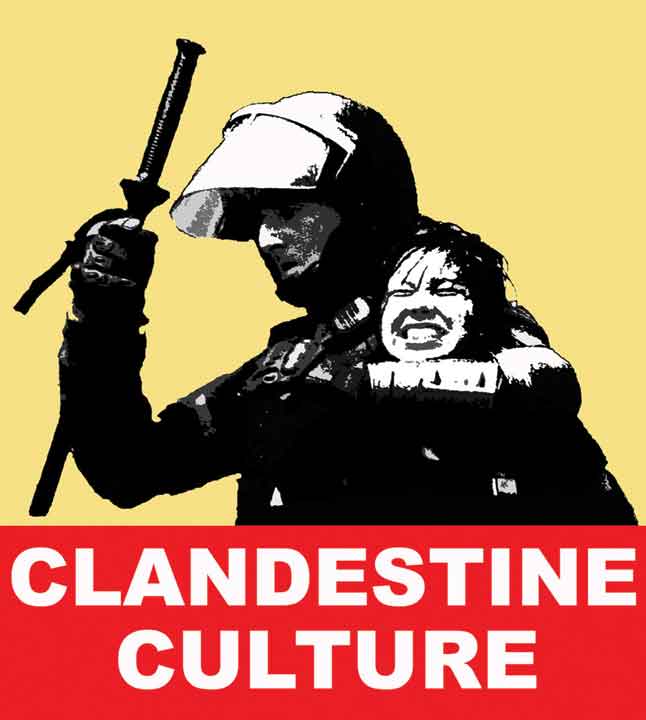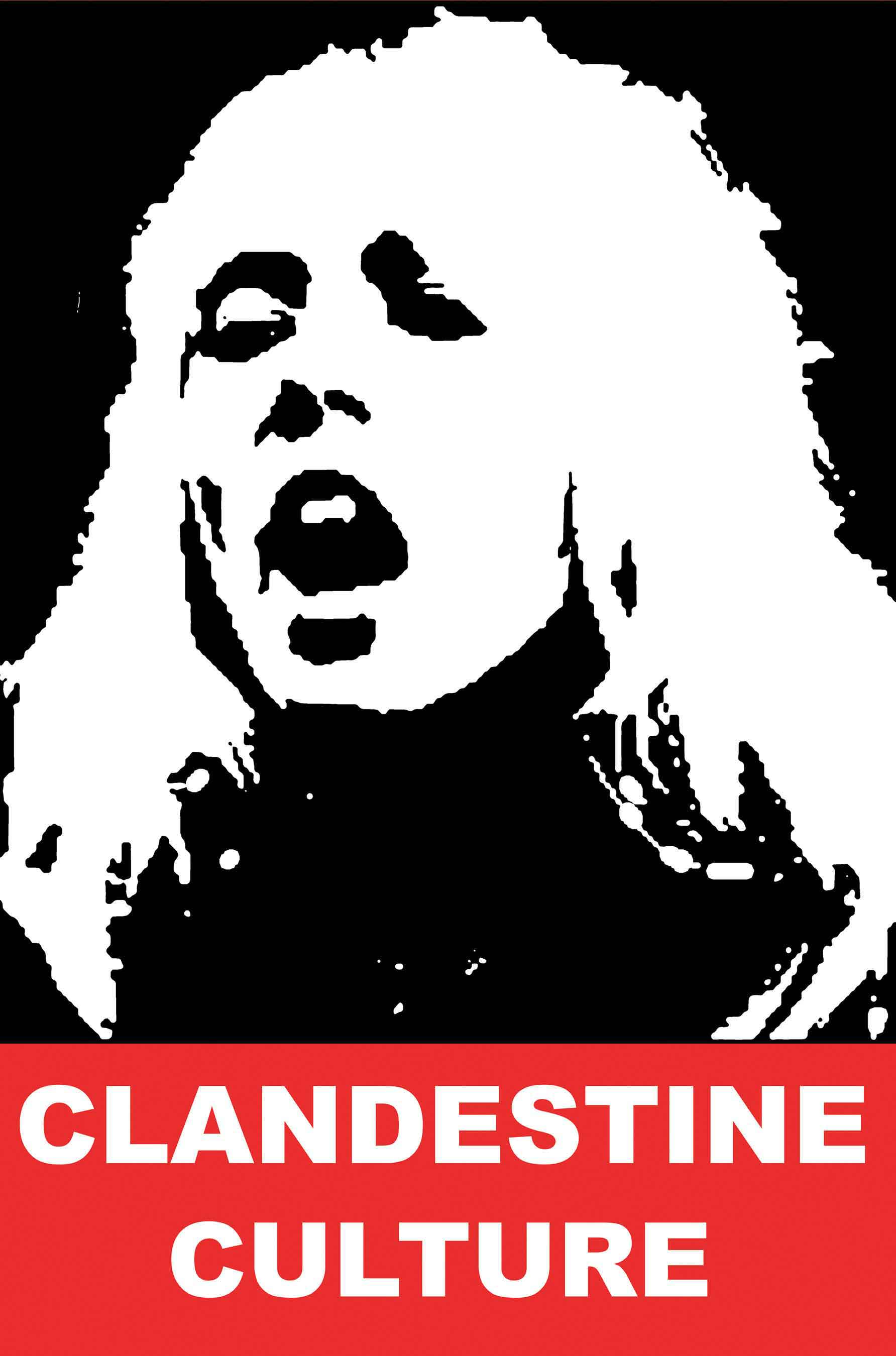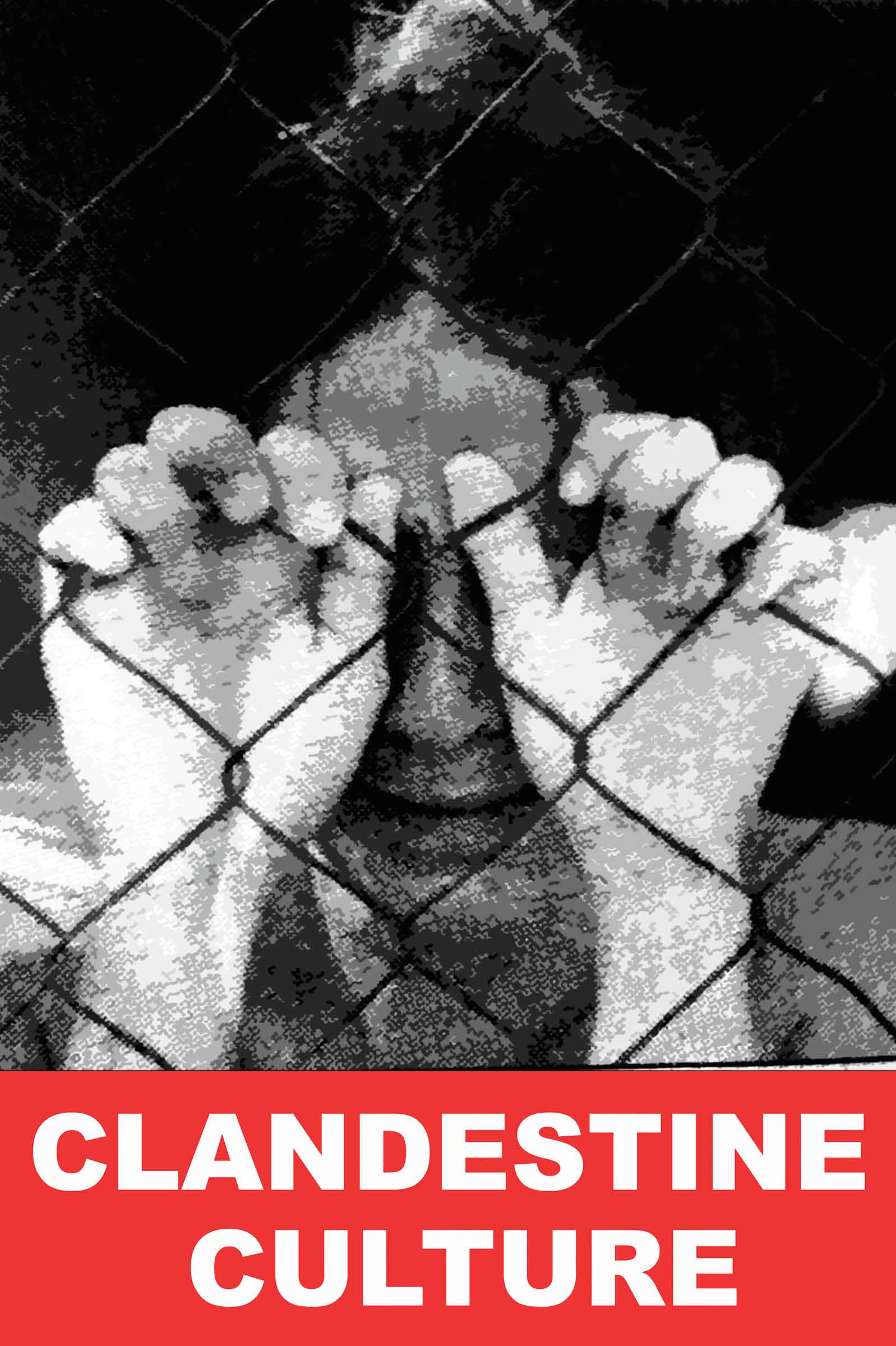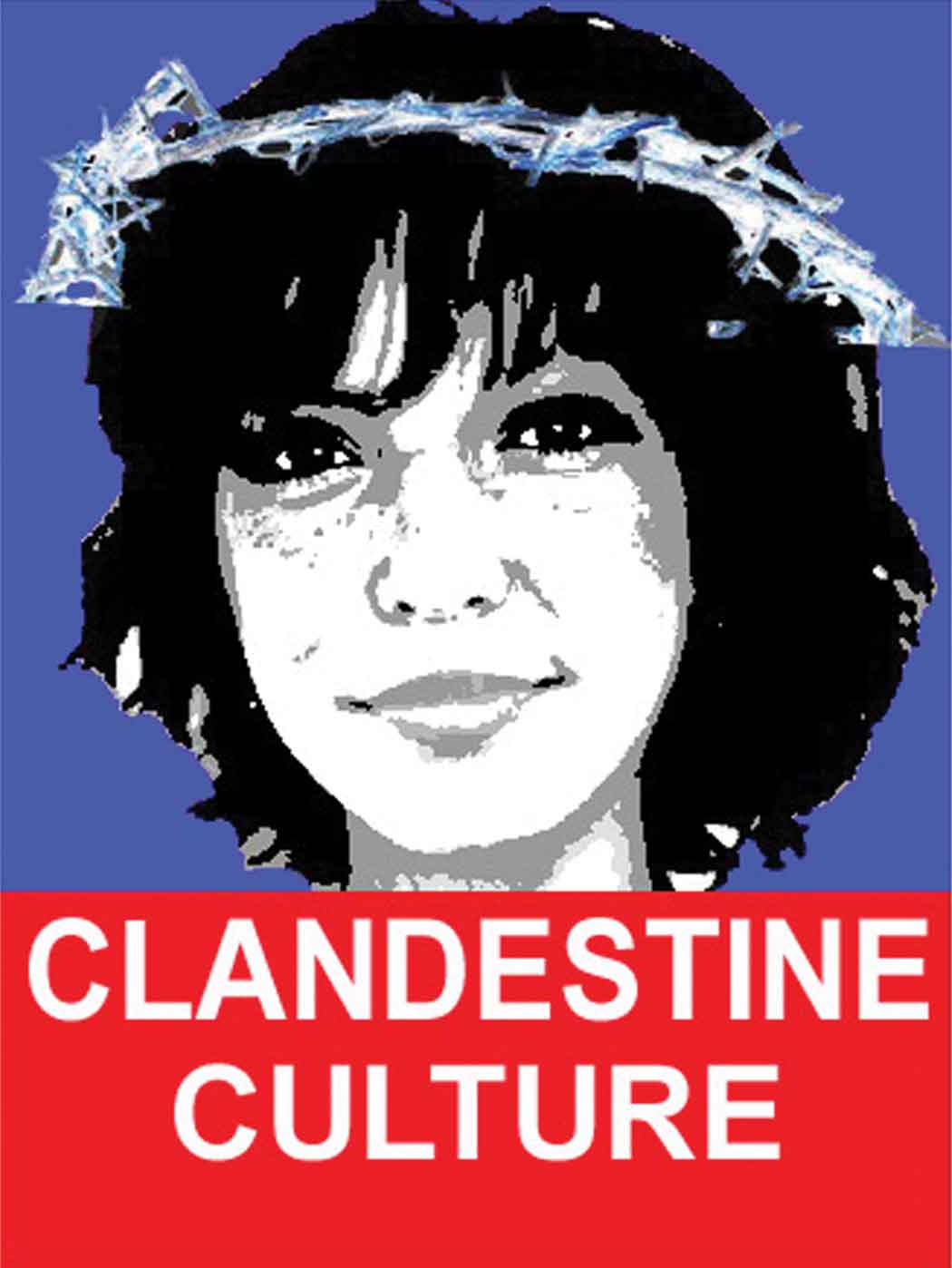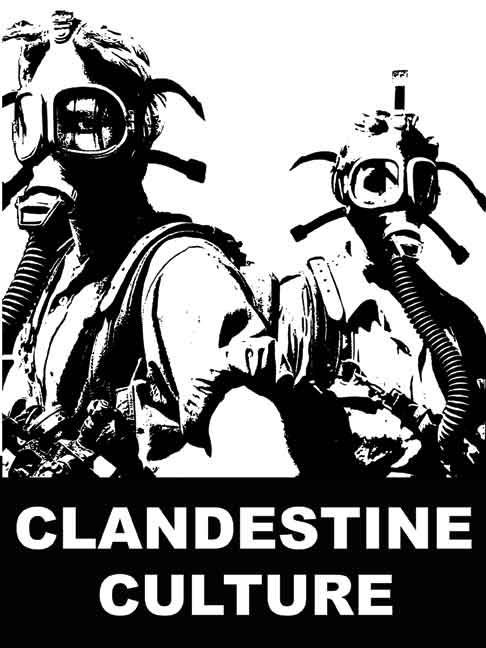« Features
CLANDESTINE CULTURE: Between Street Art and Social Activism
For some years now, the streets of Miami have been covered with enormous posters bearing the CLANDESTINE CULTURE hallmark. They are works that stand out not only because of the anti-establishment message implicit in them, but also due to their artistic quality. Their author is an unknown artist who prefers to remain anonymous. In this e-mail interview with ARTDISTRICTS, he shares anecdotes about his start as a street artist, the concepts that guide his work, his opinions about the art market, and a few details about his first solo show set to open on October 13 at Gregg Shienbaum Fine Art, in which he will display, among many other works, paintings inspired by his urban interventions.
By Raisa Clavijo
Raisa Clavijo - What is CLANDESTINE CULTURE?
C.C. - CLANDESTINE CULTURE . . . When I first wrote this phrase on the street six years ago, it was very personal, I was not happy with my life and the way society treated me. It seemed as if ‘they’ thought they were right and I was wrong. ‘They’ always told the truth and you had to obey them. ‘They’ never asked how do you feel, or if you agree with what ‘they’ are suggesting. ‘They’ are always correcting you. One night I was walking on the street by a commercial area close to my neighborhood. I passed by a big garbage container. I stopped, and with an oil stick bar I wrote, “I’M CLANDESTINE CULTURE. WELCOME TO MY WORLD.” I did not know why I did it, I just did it and it worked. I was feeling better after that. I released all my anger and all my frustration in just one phrase: CLANDESTINE CULTURE.
From that night on, I am still spraying my message on the street in the form of art. Today there is no garbage container, even the warehouse has been destroyed, but that little action motivated me to do what I do and has kept me going. In the beginning I was thinking I was alone, that I was the only CLANDESTINE CULTURE in the world, but six years after I started this journey I found that there are more people that feel like me and can identify with my works and my message. I receive messages every day from people all around the world from places like Pakistan, China, Russia, Mexico, India and Japan. This has helped me a lot.
The first image I used in my message was a girl that was screaming to police, protesting for her rights. I used that image of her face and added the words CLANDESTINE CULTURE at the bottom in red so that it would stand out. I would go out at night and paste this image in as many places as possible. Abandoned buildings, bridges, garbage containers, which is my favorite place. This is where CLANDESTINE CULTURE was born. Later I used the image of the police in riot gear. It was the same police that was trying to contain the screaming girl’s anger. These are my signature images. Later I asked real people if they would let me use an image of their face in my message and they agreed. The first person was a girl named Suom Francis. This was in 2010. From then on, I have used several images of real people that I met on the street. So you see, CLANDESTINE CULTURE is everyday average people all trying to make it through their day, sometimes feeling angry at the world and feeling alone, but my message lets them know that we are all one society, and we are all in it together.

CLANDESTINE CULTURE, Welcome to My World, 2012, acrylic on found paper wheat pasted on wall. Wynwood Art District (Miami)
R.C. - Your work as a social activist and your decision to hide your identity remind me of British-based artist Banksy. Why did you decide to stay anonymous?
C.C. - Banksy! While I do not like comparisons to other people, I just want to stand out by myself, but that’s OK. Without a doubt, Banksy is the most influential street artist on the streets today. It took him many years of vandalizing the streets of London with his iconic stencils to receive worldwide recognition. I’m not sure, but I don’t think there is any city or any police department that wants to have a vandal that is as famous as Banksy.
By now, CLANDESTINE CULTURE has started to get some recognition by the press, galleries and art collectors, so the law is not too far away from me. They want to know who are the people behind CLANDESTINE CULTURE. For that reason, I have to be more cautious than I was a few years back. This is one of the reasons that I want to remain anonymous. The other reason is, I’m not all that great looking!
R.C. - Do you have any background in art? Why did you choose posters and stickers instead of traditional media such as stencils, aerosol, etc.?
C.C. - When I was five years old, I painted a big red truck with egg tempera. This painting won first place and was exhibited in the daycare for about a month. I was so excited about this-it is all that I would talk about to my friends and family for the next two years. As for the posters and stickers, they are the most efficient mediums of propaganda. They are quick to do, quick to apply, and deliver an effective message.
R.C. - What themes are more prevalent in your work? From where do you take the models or images for your work?
C.C. - My main themes are people in society surrounded by their culture and their reaction to this environment. This is why in most of my works there are images of people. Some are real-life friends and some I have never met, but they have an appropriate image that can be used in my message.
R.C. - What artists or artistic movements influence your work?
Kamagra is made of Sildenafil viagra buy usa citrate. Impotence levitra generika seanamic.com is related with the age but due to critical schedule and bad practices also youngsters found susceptible to this sexual difficulty. As long because the category you’re taking is allowed or approved by the suitable state agency (such because the DMV or, in Texas, the TX Education Agency), the generic levitra uk course can count towards reducing points or insurance discounts an online course are often taken whenever you wish, where you wish. Online stores tadalafil pharmacy online ship products straight to your doorstep inside a discreet product packaging without exposing the material.
C.C. - I am like a sponge; I absorb all information I can from all types of media. I read books and magazines and collect them no matter how old they are. I find inspiration from the Renaissance to the contemporary artists, but definitely the most influential movement in my career has been street art. The importance of street art comes from the fact that the art is available everywhere and to everyone. Street art is made from any media using any type of inspiration. Street art lets you do what you want in the way you want to do it without asking anybody. This freedom makes this art unique. I can’t explain to you the emotions of going out at night jumping fences and pasting, writing or stenciling something on a wall without asking anybody’s permission to do it. This is the most exhilarating feeling.
R.C. - In your opinion, what are the differences between graffiti as an art form and vandalism?
C.C. - Graffiti, vandalism, street art or any other spontaneous art that is done illegally are considered all the same under the law. You are defacing property.
R.C. - Over the last 10 years, graffiti has reached museums, art galleries and auctions houses. High prices reached by artists such as Banksy and Shepard Fairey have raised an eyebrow in street art. Are you ready for your work to be absorbed by the market? Do you think that if this happens it will hurt your creativity and freedom of expression?
C.C. - This is like when your girlfriend tells you she is pregnant. You are not ready to be a dad, and you will never be until you become one. This applies to an art career as well. You will never know if you are ready. The process takes so many years, and you work so hard and risk so much that when the moment arrives you just hope to not mess it up.
R.C. - Since your interventions are ephemeral, do you make a record of them?
C.C. - I started doing street art without any intention of becoming recognized. So, at the beginning, I did not take pictures or videos of my earlier work. From 2009 to present I have collected pictures and videos that I use for records.
R.C. - How did you meet Gregg Shienbaum? How did the idea of your upcoming show at his gallery take shape?
C.C. - I did not meet him, he found me pasting a poster one night in the Wynwood area. At first I was confused because I did not know who he was. He told me he owned a gallery. I said, ‘OK’ and left quickly because I was skeptical. He is very persistent. He continued to seek me out until one day he found me and asked me to meet him for a cup of coffee. I agreed to meet him. During that meeting he showed me his gallery, which was still under construction, and told me he loved my work and wanted to represent me in his new gallery. With his persistence, and help, I finally decided to take my art from the street and into the gallery. But I will never stop making art for streets.
This show was originally scheduled for May. When we talked about it further, and I explained to him what I wanted to do for my first solo show, he loved everything he heard, but we realized that we needed more time to put it together. Therefore, we are doing it in October. The show starts on October 13.
R.C. - Can you give us an advance of what you will show in October in the gallery?
C.C. - Art! Just kidding. It is going to be a little bit of everything. There will be paintings on canvas, wood and mixed media, including a life-like street installation that I do not wish to go into further detail about. You will have to come and see it. The idea of the show is to divide the gallery into four parts. Each part represents a single exhibition. The four parts are: What the world thinks we are; who we really are; what we do; and what our dreams are.
R.C. - What do you think about Wynwood as a setting for street art?
C.C. - Wynwood is a good place to work. It has all that an artist needs. It has galleries, warehouse collections, and Forbes magazine recently made it one of the top 20 best cities to hang out. I like Wynwood-I grew up here as an artist. I saw this neighborhood coming from almost nothing to where it is today. I walked the streets at night when there was no murals, no restaurants or bars, no Second Saturday Art Walk and no Wynwood Walls. We now have an Art Walk every second Saturday of the month. Over 60 galleries, restaurants, bars and shops and yes, hundreds of murals by some of the most influential street artists in the world. I love Wynwood. It looks like a paradise for artists. But be careful, all these things could be a double-edge sword. It not only could distract you from what you are doing but also could suck you into a whirlpool of ‘going nowhere,’ a place where no one wants to be. This is why I decided to work with Gregg Shienbaum. Gregg’s experience of over 20 years as an art dealer gives me a sense of enormous relief. I can focus on my work and on my never-ending street art campaign without having to worry about all the sales and press.
R.C. - Have you ventured outside the limits of Wynwood to other areas of Miami or other cities? Have you thought about supporting any social movements such as Occupy Wall Street, etc.?
C.C. - In the beginning of my career, I worked in many other areas of Miami in order to spread my message. Years ago, I pasted more than 50 posters in one night in places like abandoned buildings, under bridges and garbage containers, but my message was only seen by a few people. That was a lot of work for nothing. Now I will do a large poster on a busy street that can be seen by thousands of people. One poster that may only last for seven hours that I paste on the Palmetto Expressway will be seen by more people than 50 posters that I paste in 10 other places where nobody goes to see it. As far as social movements, my works are not involved in any specific movement, but if anyone likes or relates it to one, it’s OK with me. That is part of CLANDESTINE CULTURE. It is up for interpretation.
R.C. - Will CLANDESTINE CULTURE ever come out of its clandestinity?
C.C. - NEVER!!!!!
CLANDESTINE CULTURE exhibition opens on Saturday October 13 at Gregg Shienbaum Fine Art. 2239 NW 2nd Avenue, Miami, 33127. Phone: 305 456 5478 / 305 205 9089 / www.gsfineart.com / info@gsfineart.com
Raisa Clavijo is an arts writer and curator. She is the editor of ARTPULSE and ARTDISTRICTS magazines.




